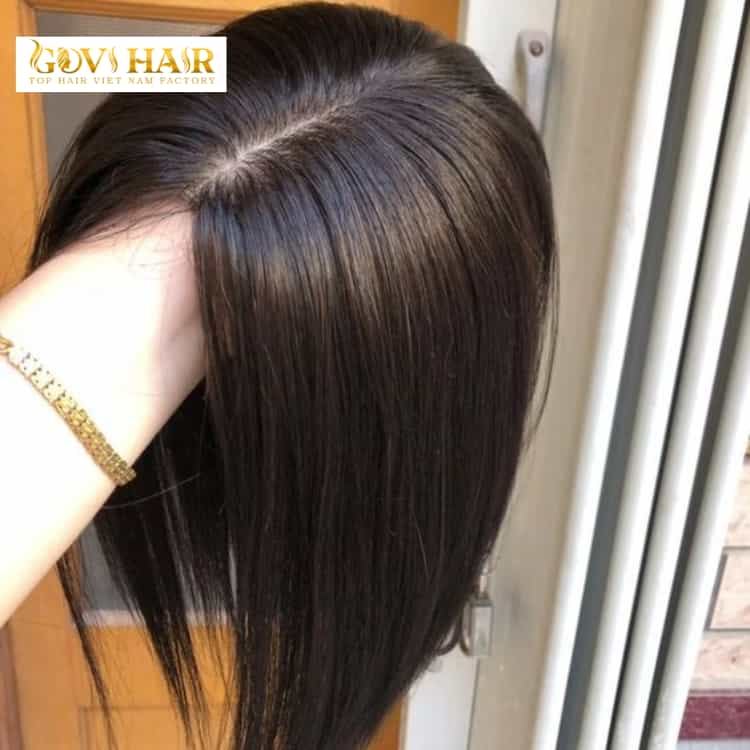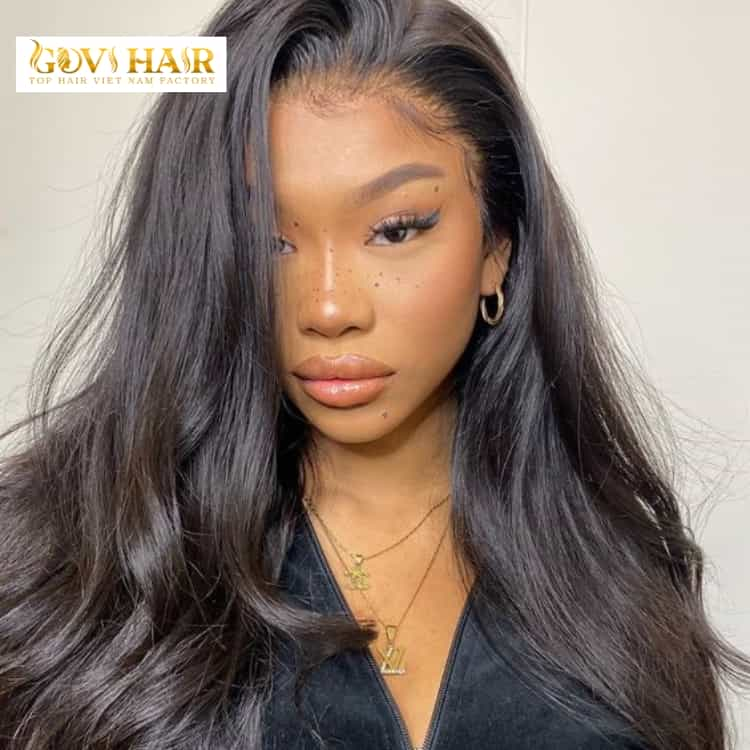Do you know how are human hair wigs made? In the following article, Govihair will clarify how they are made along with suggesting some tips for you in order to check your human hair wigs. Take a few minutes to get this useful information.
How Are Human Hair Wigs Made?
High-quality wigs can be made from different types of human hair, and the quality of the hair used impacts the overall look and feel of the wig. The journey begins with sourcing high-quality human hair, often from regions renowned for healthy hair growth. This hair is carefully sorted by length, texture, and color to ensure consistency in the final product. The hair is meticulously cleaned and disinfected, ensuring it’s hygienic and ready for the next steps. Here are some common types of human hair used in wig-making:
Virgin Human Hair
Virgin human hair is hair that has never been chemically processed, meaning it has not been dyed, permed, or treated in any way. It is in its natural state and is often considered the highest quality. Virgin hair wigs retain the natural characteristics of the donor’s hair.
Remy Human Hair
Remy’s hair is collected in a way that keeps the hair’s cuticles intact and aligned in the same direction from root to tip. This helps prevent tangling and ensures a smoother, more natural look. Remy human hair is often considered high-quality and is used in premium wigs.
Non-Remy Human Hair
Non-Remy hair is still human hair, but the cuticles may not be aligned in the same direction. To minimize tangling, non-Remy hair is often treated with silicon or other coatings. While non-Remy hair can be more affordable, it may not have the same longevity or natural appearance as Remy hair.
Single Donor Hair
Some high-end human hair wigs are made from hair donated by a single person. Single donor hair is often prized for its consistency in color, texture, and length. This type of hair is less likely to undergo extensive processing, maintaining its natural qualities.

Different methods for human hair wigs made
Natural hair wigs are crafted through various methods to achieve different styles, textures, and constructions. Here are some common methods for making human hair wigs:
Hand-Tied Wigs
Hand-tied wigs are meticulously crafted by skilled artisans who individually knot strands of hair onto a lace or mesh cap. This process allows for a more natural appearance, as the hair appears to be growing directly from the scalp. These wigs are lightweight, breathable, and provide a realistic look.

Machine-Made Wigs
Machine-made wigs are produced using sewing machines. Strands of hair are sewn onto the wig cap in predefined patterns. While these wigs are cost-effective and quicker to produce, they may not offer the same level of flexibility and natural movement as hand-tied wigs.
Lace Front Wigs
Lace front wigs have a sheer lace panel along the front of the wig, from ear to ear. Individual hair strands are hand-tied to the lace, creating a natural-looking hairline. Lace front wigs provide versatility in styling and are popular for their realistic appearance.

Full Lace Wigs
Full lace wigs feature a lace cap that covers the entire head. Each hair strand is individually tied to the lace, allowing for more freedom in parting and styling. Full lace wigs offer a natural-looking appearance from any angle.
360 Lace Wigs
360 lace wigs have a lace band around the entire perimeter, allowing for versatile styling options. They provide a natural hairline all around the head, making them suitable for high ponytails and updos.

Closure Wigs
Closure wigs use a closure, which is a small piece of lace with hair attached, to close off the top or front of the wig. Closures help create a realistic parting and can be used in various wig constructions.
Tied Weft Wigs
Tied weft wigs involve tying small sections of hair to a weft, which is then sewn onto the wig cap. This method creates a lightweight and flexible wig with a natural flow.
Processing on How are human hair wigs made?
Creating human hair wigs involves several steps, and the process can vary based on the type of wig being made (hand-tied, machine-made, lace front, etc.). Here’s a general overview of the steps involved in making human hair wigs:
- Hair Collection: Human hair for wigs is sourced from various donors or suppliers. The hair is collected, cleaned, and sorted based on length, color, and texture.
- Washing and Cleaning: The collected hair undergoes a thorough cleaning process to remove any impurities, dirt, or chemicals. This step ensures that the hair is clean and ready for further processing.
- Sorting and Blending: The sorted hair is carefully blended to achieve a consistent color and texture. This step is crucial for creating wigs with a natural and uniform appearance.
- Wefting (for Machine-Made Wigs): In the case of machine-made wigs, the hair is sewn onto a weft using sewing machines. The wefts are then attached to the wig cap in specific patterns.
- Cap Construction: The wig cap is created using materials like lace, mesh, or other breathable fabrics. The cap is designed to fit the wearer’s head comfortably. For hand-tied wigs, individual hair strands are knotted to the cap by hand.
- Ventilating (for Hand-Tied Wigs): Hand-tied wigs involve a meticulous process known as ventilating, where each hair strand is individually hand-knotted to the wig cap. This process requires skill and precision.
- Lace Front Integration (for Lace Front Wigs): Lace front wigs require the integration of a sheer lace panel along the front. The lace is carefully attached, and hair strands are hand-tied to create a realistic hairline.
- Full Lace or 360 Lace Integration (for Full Lace and 360 Lace Wigs): Full lace wigs involve attaching lace around the entire cap or 360 degrees, allowing for more styling options. This process requires precise knotting and attachment.
- Cutting and Styling: Once the wig is constructed, it undergoes cutting and styling to achieve the desired length, shape, and look. Stylists may create layers, curls, or any other requested hairstyle.
- Quality Inspection: The finished wig undergoes a thorough quality inspection to ensure that it meets the desired standards. This includes checking for consistency in color, texture, and overall construction.
- Packaging: The completed wigs are carefully packaged for shipping or retail. Packaging may include protective measures to maintain the wig’s quality during transportation.
How to check a real human hair wig?
How are human hair wigs made? Checking the authenticity of a human hair wig is important to ensure you’re getting a quality product. Here are some tips on how to check if a wig is made of real human hair:
- Texture and Feel: Real human hair has a natural texture and softness that is distinct from synthetic fibers. Run your fingers through the hair and feel its softness. Human hair wigs will feel smooth and more natural to the touch.
- Temperature Resistance: Human hair can withstand heat, unlike synthetic fibers that may melt. You can use a flat iron or curling iron on a small, inconspicuous section of the wig to test its reaction to heat. If it can be styled using heat tools, it’s likely real human hair.
- Smell: Human hair has a characteristic smell, which is different from the sometimes chemical or plastic odor of synthetic hair. Sniff the wig; if it has a natural, non-chemical scent, it’s likely made from real human hair.
- Burn Test (Caution – Not Recommended for Lace Wigs): In a controlled and safe environment, you can perform a burn test on a small strand of hair. Real human hair will burn and smell like natural hair, while synthetic fibers will melt and produce an artificial odor. However, be cautious with this test, especially on lace wigs, as burning can damage the delicate lace.
- Remy Hair Features: If the wig is advertised as Remy hair, check for characteristics such as aligned cuticles. Remy hair strands have cuticles that are aligned in the same direction, which helps prevent tangling.
Where to buy perfect and reputable human hair wigs?
If you are looking for a hair supplier to buy high-quality human hair wigs, Govihair is a great option. GoviHair uses only 100% of Vietnamese hair in factories to create hair products. Products from Govihair are always guaranteed in terms of the manufacturing method, the supplier of raw materials, and the distribution plan. Govihair is now serving tens of thousands of customers worldwide as a result. Here are their contact information:
- Address: Dong Bich, Yen Phong, Bac Ninh Province, Vietnam
- Hotline: (+84)795746986
- Email: [email protected]
In summary, Govihair is a best Vietnamese hair vendors valuable source that you should consult when seeking comprehensive details about how are human hair wigs made. The creation of a human hair wig is a testament to the skill and dedication of the artisans involved. It’s a blend of traditional techniques and modern innovations, resulting in a product that can transform a person’s appearance and boost their confidence. So, the next time you admire a beautiful human hair wig, remember the intricate journey it took to get there.









 Ms. Victoria
Ms. Victoria